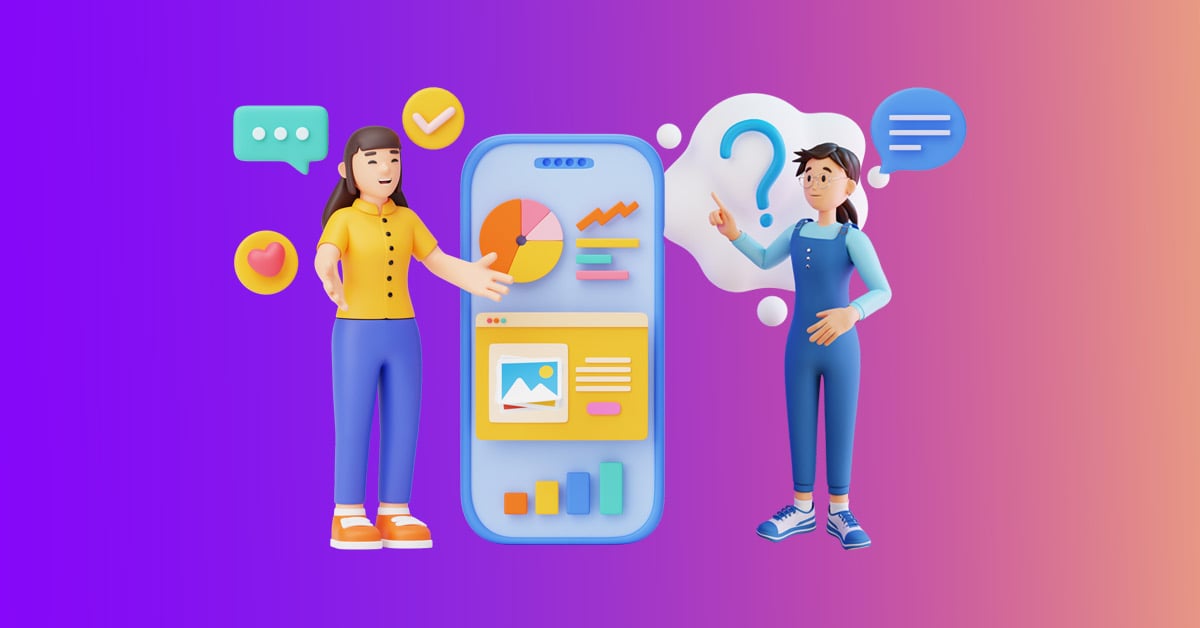
Investing in Facebook ads is one of the best marketing tactics for marketers and entrepreneurs in any industry. With precise targeting, your ads will help your brand reach new heights. However, setting up Facebook ads on your Ads Manager must consider all the dos and don’ts—including audience overlap. Preventing an audience overlap will benefit your marketing strategy and budget. That said, it’s best to avoid this at all costs or at least know how to evaluate its impact. Here’s how to see audience overlap Facebook ads.
What is Audience Overlap?
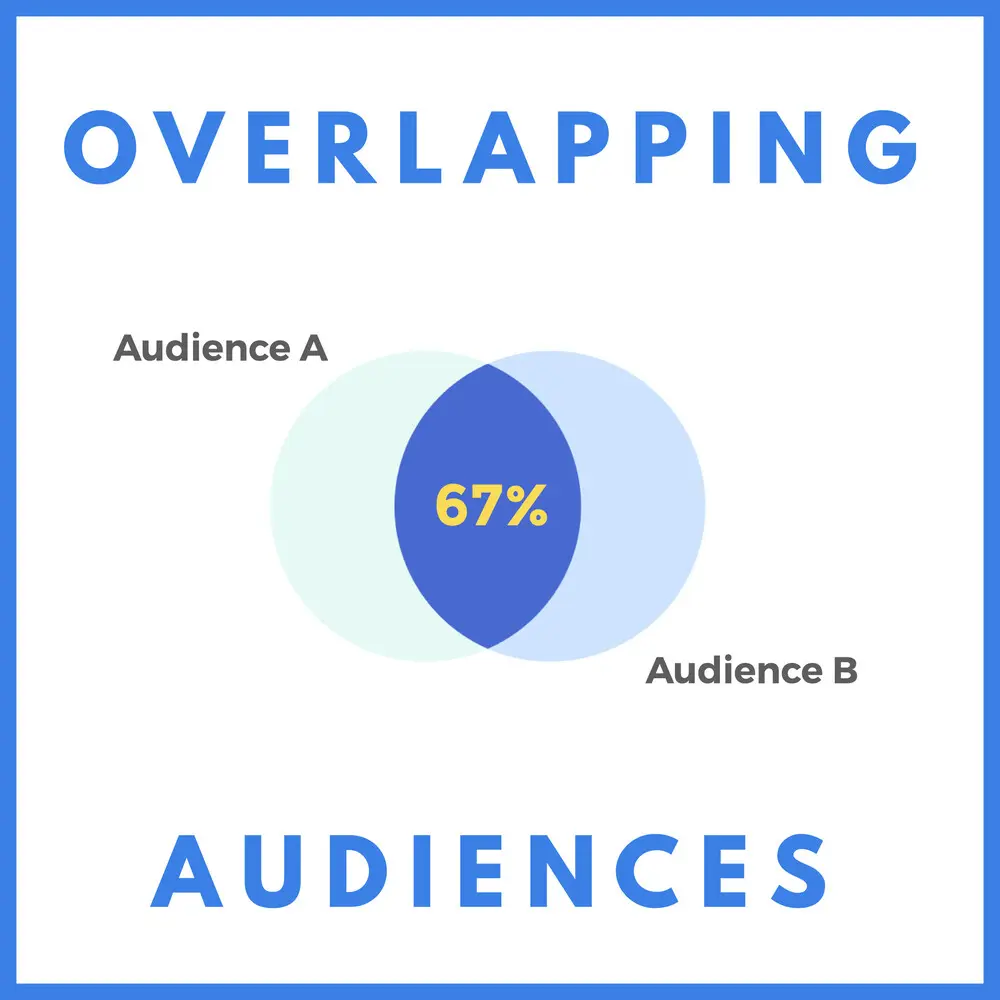
In a nutshell, audience overlap or auction overlap refers to a type of audience that will also appear in another kind of audience. For example, you have an audience lookalike at one percent and two percent. When your audiences overlap, the people in your one percent lookalike audience will also appear in your two percent audience.
To put this into another perspective, imagine segmenting your audiences into “add to carts” and “website visitors.” Audience overlap means that the people in the former group could also appear in the latter group. Doesn’t sound so life-threatening, right?
But what this does to your ads sounds alarming in terms of budget and ad effectiveness. After creating your ad sets, different ads from your Page could show in the same ad auction.
Why Audience Overlap Must Be Avoided
While audience overlap may not be detrimental to your marketing tactic, it can cause poor ad set delivery. Since the ad sets end up in the same auction and target similar audiences, different ads aren’t maximized to their full potential.
There are two reasons why audience overlap impacts your Facebook marketing strategy:
- Double ad costs
- Ad fatigue
When creating Facebook ads, you want to reach as many potential leads within your budget to gain conversions. And this is why you must know how to see audience overlap on Facebook Ads Manager.
Double ad costs
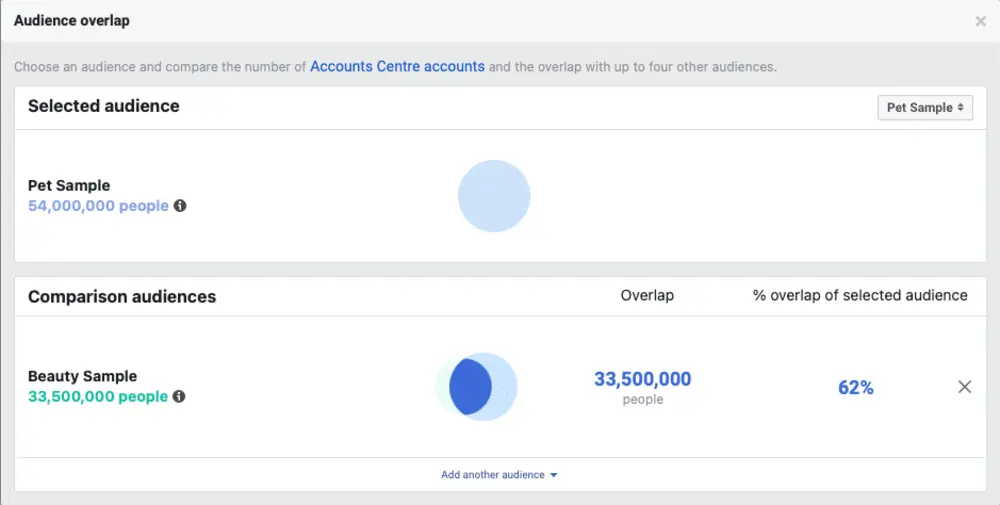
If you’re showing multiple ads to the same audiences twice, you’re also paying for those ads twice. Take this audience overlap percentage, for example. You aim to show ads to the beauty sample audience. However, your pet sample audience also shows in your beauty sample audience. It has an overlap of 62 percent, which is relatively high, with more audiences overlapping. So imagine having to pay for ads showing in both audiences, even though you’re targeting only one audience group.
Ad fatique
Another reason why audience overlap must be avoided is ad fatigue. If the same users are frequently exposed to the same ads, they can get annoyed. Worse, they could become blind to the ads, which will go unnoticed. You won’t get any responses from the audience, and some might even hide your ad or flag it as spam.
As a result, your ads won’t achieve maximum results or reach the most potential leads. This will also result in fewer conversions because ads are sometimes shown to the wrong audiences.
How Does Audience Overlap Impact Performance
When two or more ads from your Page end up in the same ad auction, Facebook shows the higher-value ad to compete in the auction. As a result, the other ads from your Page are neglected. This ensures that your ads aren’t bidding against one another.
Your Facebook ads go through a “learning phase,” where the ads explore how much conversions or engagement they can get. Auction overlap prevents ads from ending up in auctions. As a result, it can prevent ad sets from spending their highest budgets or achieving optimum results.
Running ads on multiple Pages also doesn’t prevent auction overlap. Audience overlap limits ad delivery when running ads from the same campaign, ad set, or account. And when your ad is in the “learning phase,” Facebook explores the best way to deliver ads to quality audiences. This phase creates a less stable performance with worse cost-per-action (CPA).
It’s crucial to remember that a higher overlap percentage will result in less accurate and predictable performance.
How to Check Audience Overlap Metrics
Audience overlap may not be bad, especially if the system shows small-scale numbers. That said, it’s vital to check both these metrics to understand how auction overlap will impact ad performance:
- Audience size
- Overlap percentage
Audience size refers to the number of active Facebook accounts within your ad settings. Identifying and modifying audience size involves changing your ad settings, such as locations, interests, behaviors, demographics, etc.
On the other hand, the overlap percentage pertains to the percentage of Facebook accounts that appear in two audience groups.
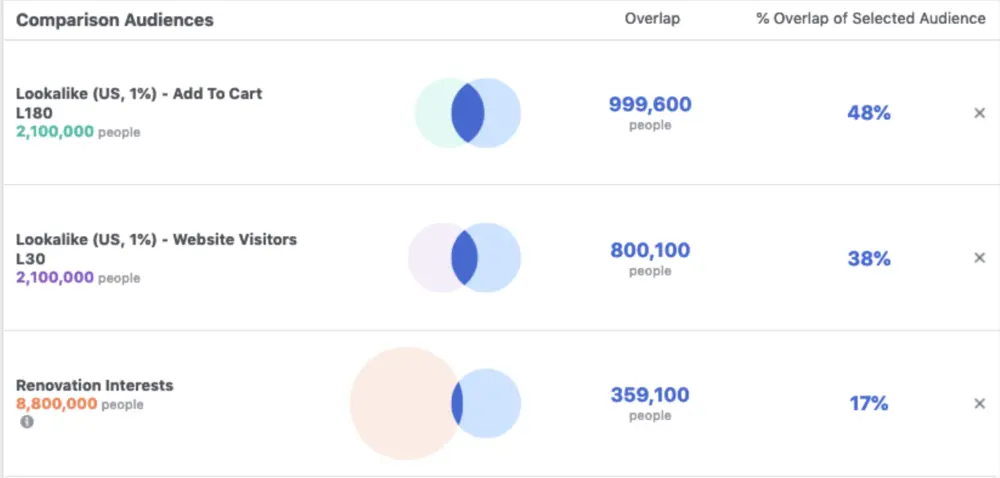
This data shows the number of people in the Comparison Audiences category, which is the audience size. It also shows the multiple overlap percentages.
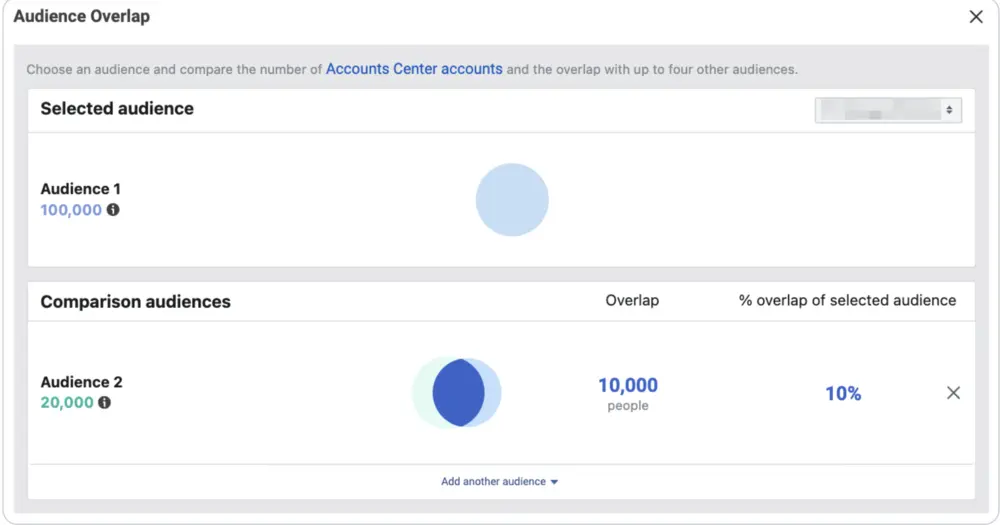
Don’t be alarmed if you see an audience overlap, especially if the numbers are relatively small, like the example.
How to See Audience Overlap Facebook Ads
Knowing how to check audience overlap on Facebook Ads Manager is crucial. Follow these steps:
1. Log into your Ads Manager account.
2. Go to Audiences
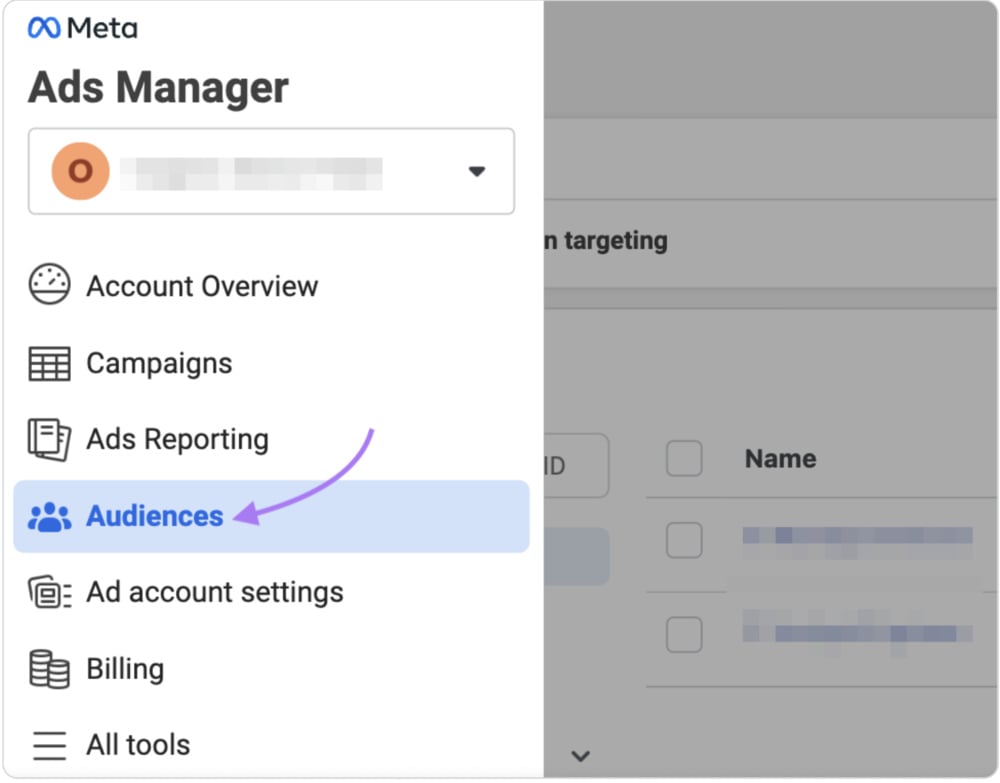
3. Tick the boxes of the types of audiences you want to compare.
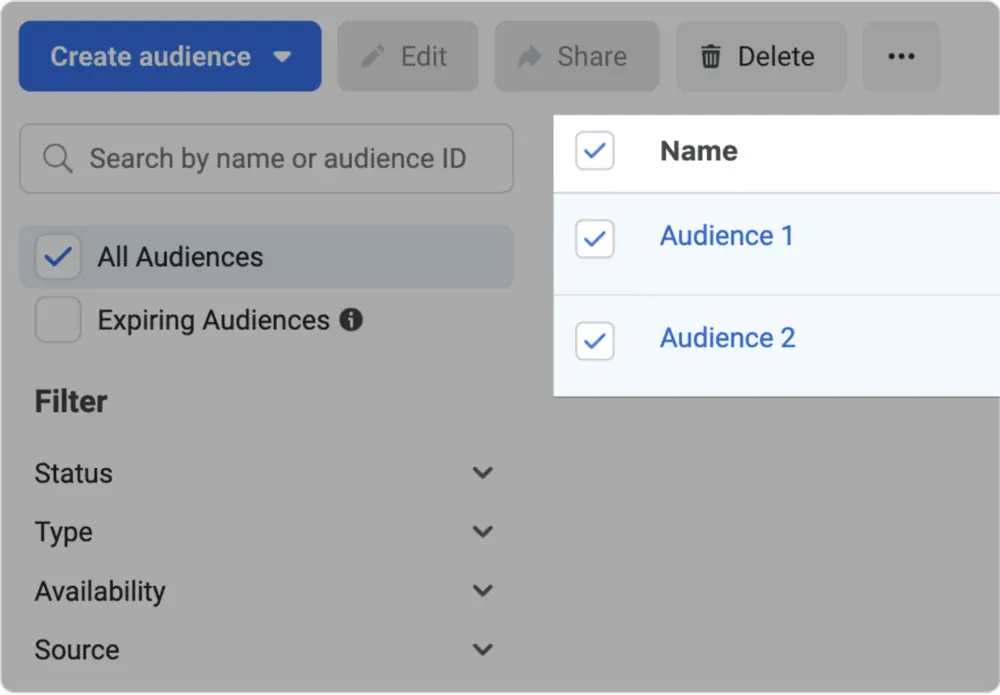
You can choose up to five. The first audience group you select will belong to the “Selected audience” category. The other audiences will belong to the “Comparison audiences” section.
However, you can always change this by clicking on the drop-down menu at the upper-right corner of the dashboard. Then, select the primary audience you want by choosing a new one. Remember that the audience order is crucial for comparison.
4. After choosing the audiences, click the meatballs menu at the top and select Show Audience Overlap.
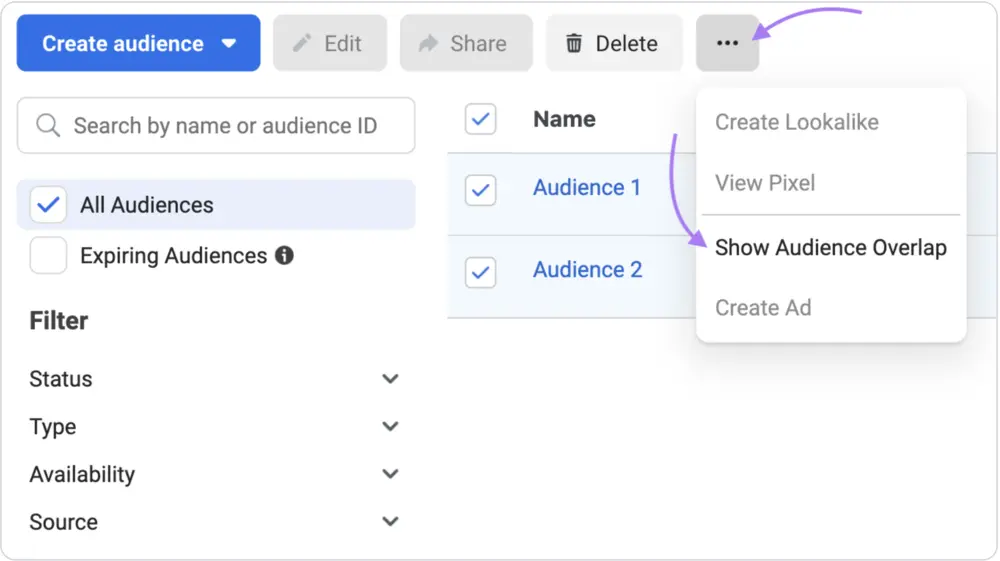
5. You will see data like the example above, which shows the Selected audience at the top and the Comparison audiences underneath.
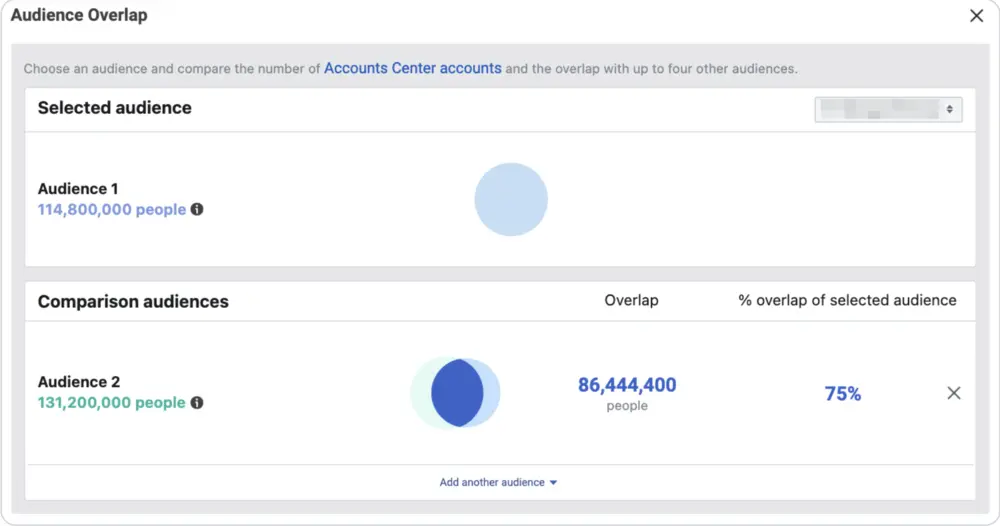
You will also see the audience size, which is the number of active accounts.
You’ll also see the percentage overlap of the selected audience. Plus, Venn diagrams show you how big or small the overlap is. On top of these details, the Overlap section also shows the number of people in both selected and comparison audiences.
Tip: Choose the ad campaign or ad set that is underperforming and compare it with the others with similar audience demographics. For instance, comparing two ad sets with similar objectives is a good idea since they’ll target similar audiences, contributing to a considerable audience overlap.
What Factors Lead to Audience Overlap
Audience overlap is inevitable because most businesses will only have a limited number of customers. Moreover, some campaigns will also target audiences with similar locations, interests, ages, behaviors, etc., causing the overlap. That said, assessing the campaign’s effectiveness on a case-by-case basis is vital. One way to tell is to evaluate how many actions or how much engagement your ad receives against the audience size.
Most importantly, preventing considerable audience overlap is essential to optimizing ad delivery and avoiding ad budget waste.
Here are some reasons causing audience overlap:
- Poor audience research. Knowing your audience well is vital to ad delivery. Showing your campaigns to potential customers will contribute to higher conversions and engagement. Inefficient audience research is one of the culprits of audience overlap. If you’re not drilling down on your target audience, you deliver your ad sets to broad audiences. And this will lead to inaccurate and unfavorable results.
- Broad audience segmentation. When researching audiences, set precise and accurate parameters for better ad results. Some marketers will bank on a broader set of audiences to be on the safe side. However, marketing to a broad group of people could mean focusing on the wrong audiences. For example, you might be selling mobile phones to teenagers who can’t afford to buy one. On the other hand, a narrow target audience also means you’ll be missing massive conversion opportunities. That said, it’s crucial to identify exact audience demographics and psychographics for better audience segmentation.
- Small ad budget and configurations. Another reason how audience overlap can impact ad performance is having a small budget. If there is a considerable overlap percentage, meaning the number of people shown in multiple audiences is relatively significant, the ads stay longer in the learning phase. And this could result in higher bid costs, which is unfavorable for campaigns with smaller ad budgets. It will mean your ad bids are reduced, and you might win fewer auctions. As a result, ads are shown less frequently.
Tips for Better Audience Targeting
Knowing how to see audience overlap in Facebook ads will help in better ad delivery. However, some auction overlaps may not impact ad performance much, especially with smaller percentages.
To get quality ad delivery from audience overlap, you can:
- Combine overlapping ad sets: If your ad sets are targeting similar audiences, it’s best to combine them. Combining similar ad sets with similar audiences means you’ll have a higher budget to spare, increasing the chances of being shown to potential customers.
- Refine your targeting: Ensure each ad set is shown to a specific audience by identifying precise age, location, gender, behavior, interest, etc. Leverage Custom or Lookalike audiences to make research and segmentation easier.
Speaking of better targeting, follow these audience-targeting best practices:
1. Use Facebook’s relevance diagnostics
You can improve targeting by leveraging Facebook’s ad relevance diagnostics. If your ads are underperforming, you can use this tool to help understand which aspects need adjustments. Tweak your ad’s visuals, copy, post-click experience, and more to meet advertising objectives.
2. Start with broad targeting
This tip might contradict what was mentioned earlier. But take this tip if you’re dipping your toes into Meta’s Ads Manager and have no idea who to target. You can create a campaign with a brand awareness objective rather than a conversion-centric goal. It could be basic targeting within a large geographic area and broad demographic parameters. This will help refine your audience targeting, allowing you to focus on a narrower target audience later.
3. Target competitors’ audiences
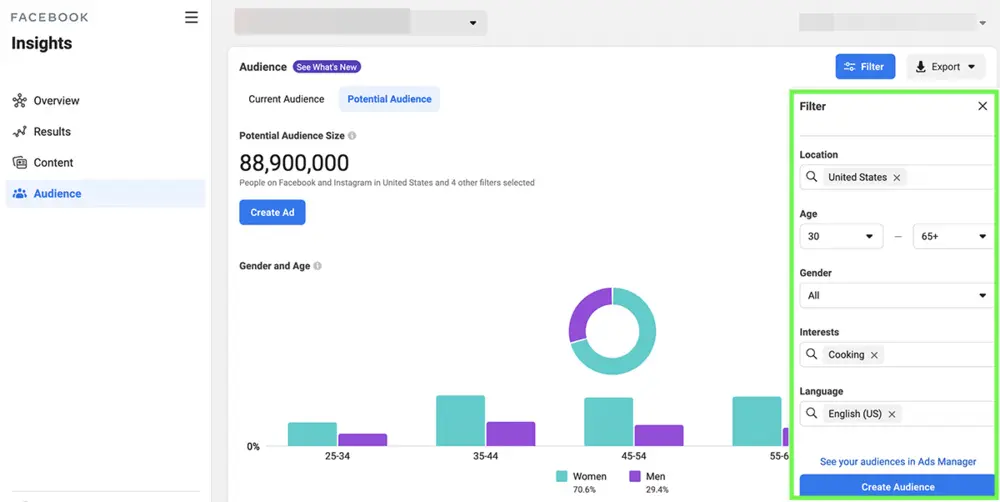
If you’re a new business doing Facebook ads, there’s no better place to look than your competitors. Use Audience Insights to get information from your competitors. You can do this by going into the Audience Insights dashboard and checking the Top Pages section to see which pages your target audience is connecting with. You can then enter your competitors’ names in the Filter section tool to see if you can gain additional information that helps target audiences better.
4. Set high-value Lookalike audiences
Lookalike audiences let you curate a list of people with similar demographics and psychographics. Facebook will gather audiences with the same characteristics as those already engaged with your brand. Before creating the Lookalike Audience list, create a Custom Audience and set parameters. Then, select the Lookalike Audience menu and make a high-value custom audience based on your Custom Audience list.
5. Take advantage of layered targeting
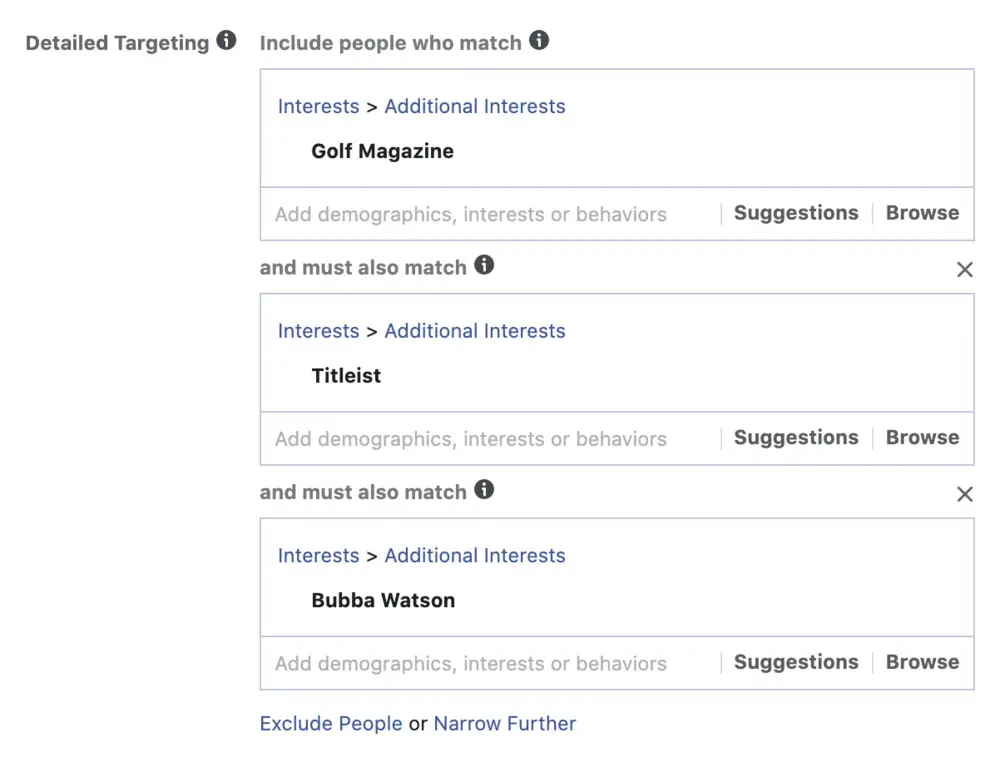
Layered targeting helps you combine targeting parameters and narrow them down to show ads only to hyper-focused audiences. Layered targeting ensures you show ad sets to people who will likely buy or engage with your brand. If you’re selling drawing tablets to graphic designers, ensure granular targeting in the demographics, interests, and behaviors categories. This will ensure you’re not only selling to graphic designers, but those who are looking for drawing tablets and will likely buy them.
6. Remarket to fans and existing customers
If your marketing objective is conversions, remarketing or retargeting is one way to achieve this. Targeting customers who have already engaged with your brand, visited your website, or purchased from you leads to higher conversions. You can target existing fans and customers in two ways. One is to create a Custom Audience list and set configurations on the type of visitors you want to target. The second way is to connect your CRM account and qualify audiences based on the data.
7. Select the Engaged Shoppers option
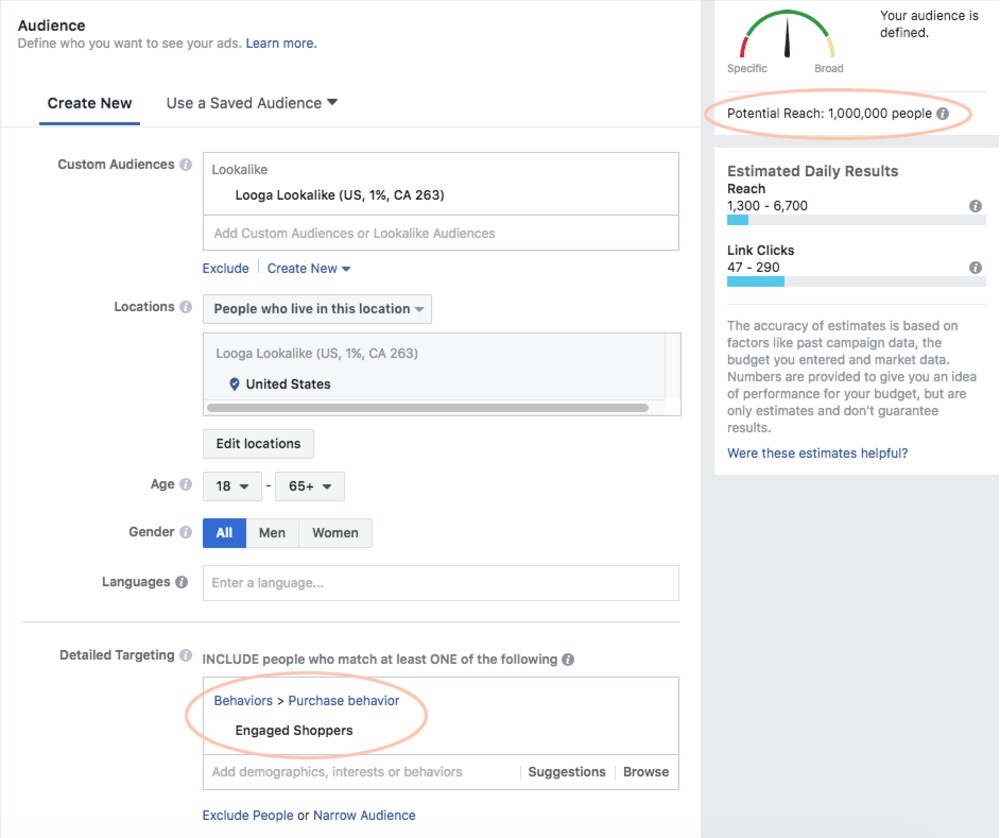
Another way to increase conversions is to select the Engaged Shoppers feature on your Ads Manager. This feature focused on audiences who clicked the Shop Now button in the last week. Use this option to target people who have bought from an ad recently. Go to Audience, select Detailed Targeting, type, and click Engaged Shoppers.
Conclusion
Knowing how to check audience overlap and evaluate how it’s affecting ad performance will optimize your marketing campaigns. Moreover, proper audience research and segmentation allow you to deliver ads to the right people. Pair these Facebook advertising strategies with an adequate budget; your ads could win bids and improve exposure.
Additionally, compelling ad designs contribute to success. That said, ensure you’re entrusting the design process to a team of creatives. Let Penji’s professional designers craft designs that persuade people to click and purchase.
Sign up now and use the promo code GETPENJI25 for a special 25 percent discount!
About the author
Table of Contents
- What is Audience Overlap?
- Why Audience Overlap Must Be Avoided
- How Does Audience Overlap Impact Performance
- How to Check Audience Overlap Metrics
- How to See Audience Overlap Facebook Ads
- What Factors Lead to Audience Overlap
- Tips for Better Audience Targeting
- 1. Use Facebook’s relevance diagnostics
- 2. Start with broad targeting
- 3. Target competitors’ audiences
- 4. Set high-value Lookalike audiences
- 5. Take advantage of layered targeting
- 6. Remarket to fans and existing customers
- 7. Select the Engaged Shoppers option
- Conclusion











